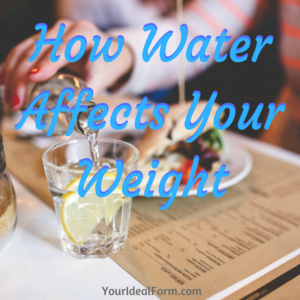
In case you’ve ever wondered how something with zero calories and some say zero taste can have an effect on your weight, this post is for you.
You retain water after eating.
Let me start by explaining just how water retention in the body works. When you eat a big meal, all that food heads to your stomach to start being digested. To absorb the nutrients in our food, the stomach breaks things down and turns it into a soup. To get things soupy, the body siphons some of the water out of our bloodstream and into our stomachs. This has the effect of making the blood thicker, so the body signals to the brain “hey, we need more water!” The brain then signals for thirst, and you drink some water. Once digestion is done, that excess water that was in your gut goes back into your system. Now there is too much water, so you eventually pee it out. This whole process can take up to 12 hours. In the meantime though, you could be carrying up to two pounds of excess water around. Water is heavy. A 20-ounce bottle of water weighs a pound and a half.
You retain water after a workout.
A similar thing happens after an intense workout. While protein builds muscle, water aids in muscle repair and recovery after a workout, so water gets siphoned off to your muscles. This is what causes that post-workout “pump” where muscles seem to look a bit bigger than normal immediately following a weight lifting session. They’re just hoarding your water.
If you stay properly hydrated, your body can still use some water for digestion or muscle recovery without triggering the thirst centers of the brain to compensate.
You retain water at certain points in your cycle.
Bloating can make us feel fat, and then stepping on the scale can just make us feel worse. Take heart, however, because…
Water retention adds temporary weight, but NOT fat.
I’ve gone over how water can make it seem as if you’ve gained weight. You have temporarily gained “weight”, but what you have not gained is fat. This is why it is a good idea to schedule your weigh-ins for first thing in the morning, after using the toilet. You’ve had all night to digest your last meal, and so it’s right about time for you to shed some of that excess water.
Water can keep you from overeating.
Now let’s look at how water can actually help us lose weight. Many lists of healthy eating tips include drinking a glass of water before each meal. This helps your stomach hit that pleasantly full feeling sooner, so you don’t overeat. Often times, when you think you might be hungry, you’re actually just thirsty. Try drinking some water and waiting 15 minutes to see if the craving passes. Staying properly hydrated can improve your performance in the gym and help you recover quicker, which can help you burn more calories during your workout.
Stick to water, you probably don’t need Gatorade.
Speaking of workouts, don’t make the mistake of trying to quench your thirst at the gym with high calorie “performance” drinks. Unless your workout goes for longer than an hour, you don’t need the electrolytes in drinks like Gatorade or Powerade. Water is plenty sufficient, and doesn’t have extra calories.
How to get more water in your day.
If you don’t think you are getting enough water in your day, here are some things you can do to help you stay hydrated:
- Set a timer to go off once an hour to remind you to drink some water.
- Buy a water bottle and keep it handy; buy one for home and a separate one for work so you’re never without one. (I have a water bottle at home, one at work, one in my gym bag, and one in my work laptop bag for when I do an activity immediately after work.)
- If water is too boring for your tastes, try infusing your water with lemon, strawberries or cucumber for a refreshing twist. They even sell water bottles with a special compartment to put the fruit so you don’t have to worry about accidentally choking on a strawberry.
- You can also buy zero-calorie water enhancers that can give your water some flavor.
- If you like carbonation, try seltzer water which can be found in a variety of flavors.
How much water is enough?
So now that you are all pumped to drink more water, you may be wondering just how much “more” is more. There is the often touted “eight glasses a day”. But what size glass are they using? As with most things surrounding healthy eating, there is no one-size fits all answer for everyone. That said, there is an easy way to tell how hydrated you are: check the color of your pee. This infographic from the Cleveland Clinic details how to tell if you are hydrated enough, or whether you could use some more water. Drink up!
